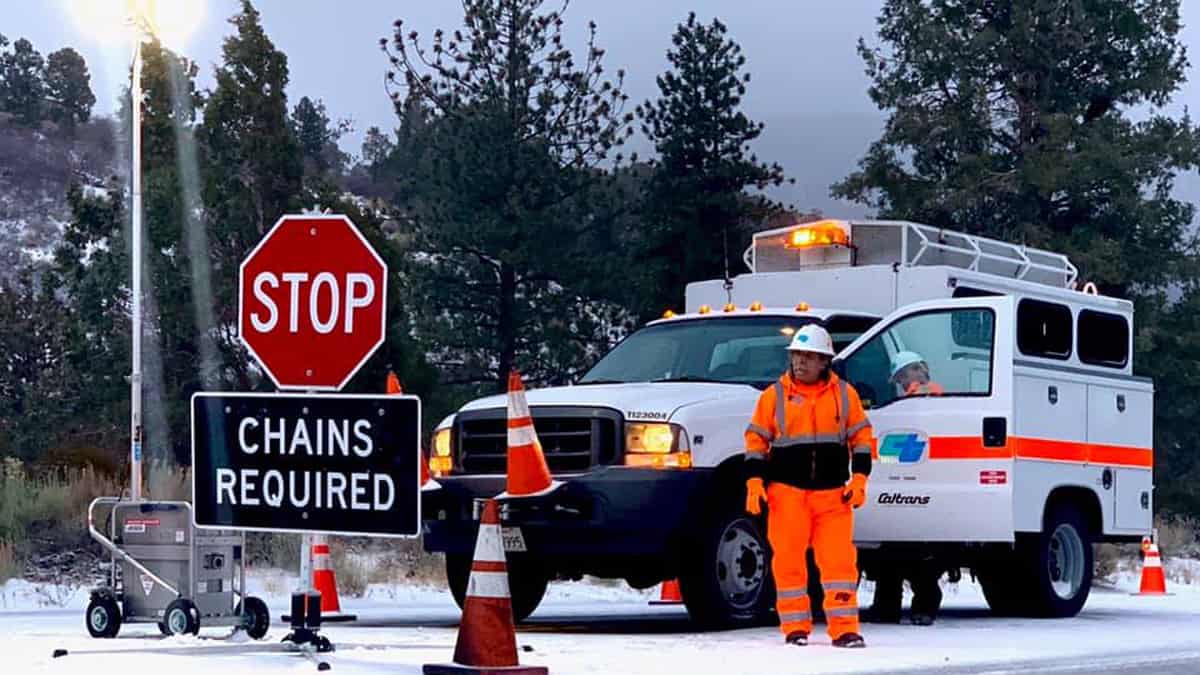We hope all of you had a safe and merry Christmas! The mountains of Southern California are becoming snow covered, just one day too late for a white Christmas. Truckers heading through this part of the country will likely have to chain up and prepare for blizzard conditions. By this weekend, the storm will slam the Great Plains and the Midwest.
A strong low-pressure system is entering Southern California, producing plenty of mountain snow and valley rain. The highest snowfall totals of 12 to 24 inches will accumulate the rest of today and tonight, Dec. 26, in the high elevations of Ventura, Los Angeles, San Bernardino, Riverside and San Diego counties, with locally heavier amounts up to 30 inches. This is primarily for areas above 5,000 feet in altitude, with up to 12 inches possible in many elevations as low as 4,000 feet. Around the cities of Tehachapi and Grapevine, elevations above 3,000 feet could see up to 18 inches, with a few inches as low as 2,500 feet. Some peaks in Santa Barbara County will see up to 14 inches.
Gusty winds of 50 to 60 mph will result in blowing snow and occasional whiteout conditions, in addition to potential power outages and roadblocks. Portions of I-5 could become treacherous through Tejon Pass. The storm will also affect several state routes, and the California Department of Transportation (Caltrans) has already posted closures.
Other California cities where drivers may run into trouble are Lockwood Valley, Mount Pinos, Acton, Mount Wilson, Sandberg, Crestline, Lake Arrowhead, Big Bear City, Big Bear Lake, Running Springs and Wrightwood. Check chain laws here for the latest updates on winter driving.
Down below, look for heavy rainfall, flooding potential and gusty winds from Los Angeles to San Diego. This includes coastal communities as well areas in southeastern California east of the mountains. Rainfall rates will approach 1 inch per hour at times, with total accumulations of 2 to 3 inches in some spots.
According to the National Weather Service (NWS), urban and small stream flooding may already be happening in places such as Chula Vista, Oceanside, Carlsbad, Temecula, El Cajon, Vista, San Clemente, Encinitas, National City and La Mesa. Flash flooding is possible, especially in areas with poor drainage systems and clogged catch basins.
Strong winds may blow down utility lines, knocking out power and possibly forcing road closures. Drivers may run into delays on I-5, I-8, I-10, I-15, I-40, US-101 and the Pacific Coast Highway.
The upper-level low pressure associated with the storm is just to the west of the Channel Islands – about 77 miles southwest of Los Angeles – and in a somewhat rare event the surface low pressure is right under the upper low. Most of the time the upper low connected to southern California storms is over Oregon or northern California. The orientation of the storm, along with very cold air aloft, are making the atmosphere increasingly unstable. This is enhancing the snowfall, rainfall and winds.
This storm will move into the Four Corners region by tomorrow, Dec. 27, fading a bit tomorrow night. Flagstaff, Arizona, and surrounding areas will see up to 12 inches of snowfall. This may affect travel on I-17 and I-40. Some high elevations in eastern and southeastern Arizona will also see up to 12 inches. In the northwest part of the state, in the Mojave Desert, some peaks will get 10 to 14 inches of total snowfall. Winds will be gusty in some areas but may not be as strong as gusts in California today. The storm could also drop up to 15 inches of snowfall in the high elevations to the west and north of Albuquerque, New Mexico.
Looking Ahead
By the weekend, this same storm will strengthen and track northeastward through portions of the Plains and Midwest, from northeastern Colorado to Nebraska, the Dakotas and Minnesota. Snowfall rates will increase and winds will be strong. Within the target zone outlined on the FreightWaves SONAR Critical Events map below, snowfall totals of 4 to 12 inches are likely, with locally higher totals. At this time, the highest amounts are likely to be in South Dakota and eastern North Dakota, as well as western and central Minnesota. Wind gusts of 40 to 50 mph will result in blowing/drifting snow and occasional blizzard-like conditions.
This storm could cause major transportation issues on the roads, rails and in the air, along with difficulty loading/unloading freight at intermodal ramps and at the Port of Duluth, Minnesota. Flight delays/cancellations may impact what minimal air cargo is scheduled to leave from/arrive at Hector International Airport (ICAO code: KFAR) in Fargo, North Dakota. Significant business disruptions over the weekend and into Monday also may occur. Numerous road, airport and rail closures should be expected during this time period. These assets at risk are color coded in SONAR Critical Events.
Major interstates within the risk zone that will experience moderate to major impacts include I-80, I-76, I-90, I-94 and I-29. Impacts will include prolonged slowdowns or road closures possibly lasting 12 hours or more. Scattered power outages are likely due to the strong winds.
Other notable weather today, Dec. 26
A few more inches of snowfall will accumulate along the I-29 corridor from Grand Forks, North Dakota, to Grand Rapids and International Falls in Minnesota. Some streets may be covered with a glaze of ice under the snow.
Later tonight and tomorrow, Dec. 27, scattered areas of snow, sleet and freezing rain will develop in upstate New York and interior New England. Watch out for icy conditions from the Adirondacks to the northern Berkshires in western Massachusetts, as well as portions of the Green and White mountains.
Have a great day, and be careful out there!










